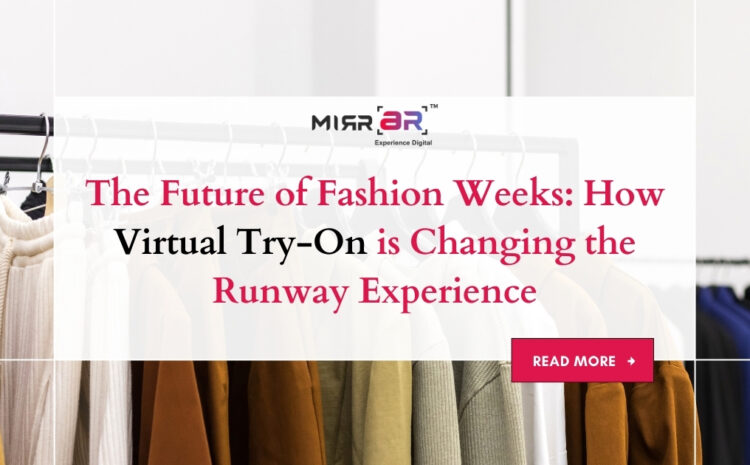Fashion Weeks—long considered the pinnacle of creativity, exclusivity, and glamour in the fashion world—are now undergoing a dramatic transformation. From New York to Paris, Milan to Tokyo, runways are increasingly blending the physical and digital, ushering in a new era of immersive experiences. One of the most disruptive innovations leading this change is Virtual Try-On (VTO). Powered by Augmented Reality (AR), Artificial Intelligence (AI), and real-time 3D rendering, VTO is not only transforming how consumers shop but also revolutionizing how brands present, promote, and personalize fashion on the runway.
At the forefront of this digital revolution is MirrAR, a leading VTO platform redefining how fashion brands engage with audiences before, during, and after Fashion Weeks.
The Traditional Runway: A Legacy of Limitation
Traditionally, Fashion Weeks have been exclusive events designed for industry insiders—buyers, journalists, influencers, and celebrities. While these runways showcase the creative essence of upcoming collections, they often fail to create a tangible, accessible experience for end consumers. Moreover, the gap between a runway debut and actual retail availability often spans months, diluting the immediacy of consumer interest.
In a world that thrives on instant gratification and personalization, these time lags and access barriers are becoming increasingly outdated. That’s where VTO steps in.
Virtual Try-On: Democratizing the Front Row
With MirrAR’s cutting-edge VTO technology, fashion lovers no longer need front-row passes or insider connections to engage with new collections. During and immediately after Fashion Week, consumers can virtually try on pieces straight from the runway in real-time using their smartphones, tablets, or smart mirrors in retail stores.
This tech allows users to experience garments in high-definition 3D, see how they move and drape on their bodies, and interact with them at a level of detail that goes far beyond 2D imagery or even video.
Enhancing Buyer and Designer Interactions
Fashion Weeks are also crucial buying seasons for retail buyers who stock upcoming collections for their stores. VTO enables instant and immersive sampling of collections, eliminating the need for physical samples in many cases. With MirrAR’s real-time data insights, designers can track which pieces receive the most try-ons, engagement, and even pre-orders—empowering more strategic production decisions.
For example, if a particular coat garners thousands of virtual try-ons and wish-list adds within hours of its runway debut, brands can fast-track its production and plan accordingly. This reduces overproduction, aligns with sustainability goals, and ensures consumer demand is met in real-time.
Blurring Physical and Digital Realms with MirrAR
What sets MirrAR apart is its ability to deliver high-fidelity, hyper-realistic virtual garments. Through AR overlays and AI-powered personalization, MirrAR creates a mirror-like experience where users can see how the clothing fits their unique body type, skin tone, and personal style preferences. This realism adds significant emotional and functional value, turning passive viewers into active participants.
During fashion weeks, brands can integrate MirrAR’s VTO into their digital showrooms or on-site installations, allowing guests and remote viewers to “try on” runway pieces as the models walk. This interactivity makes Fashion Week more inclusive, shareable, and commerce-ready.
Also Read: How Virtual Try-On is Paving the Way for Ethical and Slow Fashion Movements
A New Era of See Now, Try Now, Buy Now
One of the biggest shifts VTO is driving is the move toward the “See Now, Try Now, Buy Now” model. Fashion shows are becoming shoppable experiences. With just a tap, users can virtually try on a newly debuted piece, get style recommendations, and make a purchase—no waiting for months until retail drops.
This immediacy not only boosts sales but also shortens the fashion cycle, helping brands stay more agile in a highly competitive, trend-driven market.
Sustainability and Slow Fashion Integration
Fashion Weeks are increasingly being scrutinized for their environmental impact. By digitizing try-ons, reducing the need for mass samples, and minimizing waste, VTO becomes a powerful ally in promoting sustainable and slow fashion principles. MirrAR’s VTO helps brands cut down on physical trials and returns, leading to smarter inventory planning and less environmental burden.
Furthermore, digital runways and virtual showcases open the door to global participation without the carbon footprint of travel, large-scale productions, and wasteful packaging.
Data-Driven Creativity
Another unsung benefit of VTO at Fashion Weeks is data. Through VTO, designers gain access to real-time consumer insights—what’s being tried on the most, which combinations are favored, what feedback users leave—all of which can be fed back into the design process.
For emerging designers and luxury brands alike, this data becomes an invaluable creative and commercial tool, helping align artistic vision with market realities.
Looking Ahead: Fashion Weeks in the Metaverse?
With technologies like MirrAR expanding into the metaverse, Fashion Weeks are poised to become fully immersive digital experiences. Virtual fashion shows, complete with avatars, VTO capabilities, and even NFT-based fashion drops, are already gaining traction. MirrAR is innovating in this space, enabling brands to create immersive, futuristic experiences that combine the artistry of fashion with the interactivity of gaming.
The future of Fashion Weeks is not just about what’s shown but how it’s experienced. And with VTO, that experience becomes limitless, personal, and powerful.
Final Thoughts
Fashion is about expression, identity, and connection—and technology is now the bridge that brings all these elements together in real-time, globally. Through its AI- and AR-driven VTO solutions, MirrAR is not just enhancing the shopping experience but revolutionizing the very fabric of how fashion is created, showcased, and celebrated.
As we look to the future, one thing is certain: Fashion Weeks will never be the same again—and that’s a beautiful thing.
